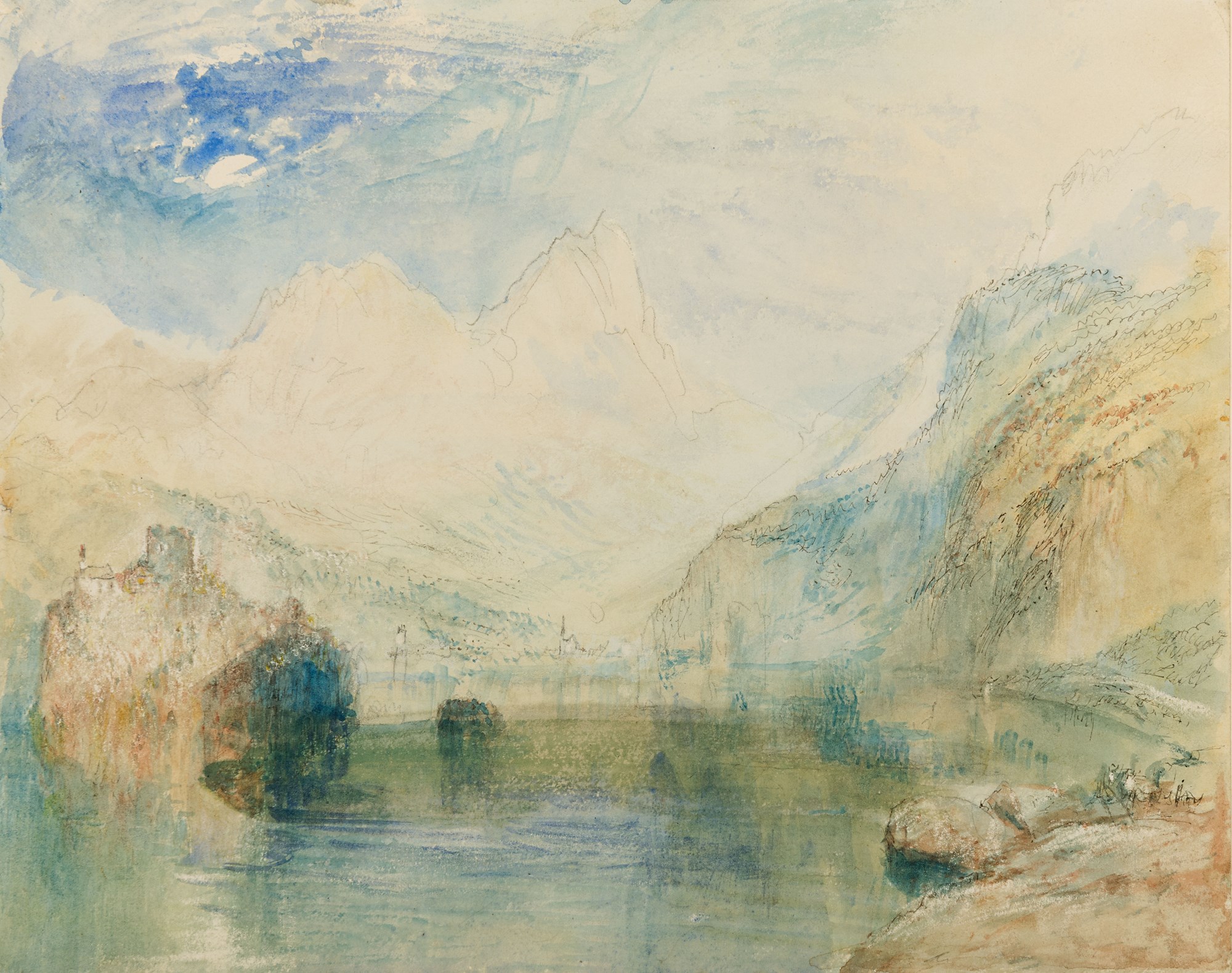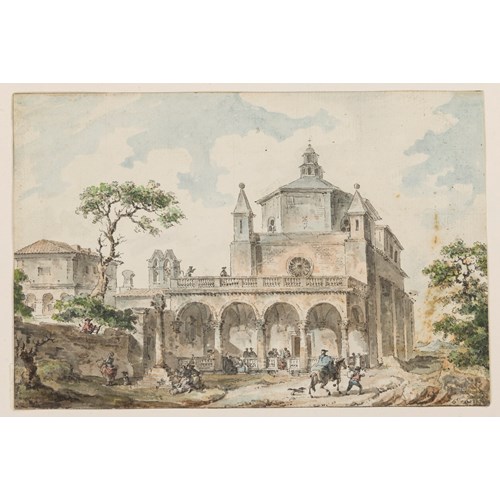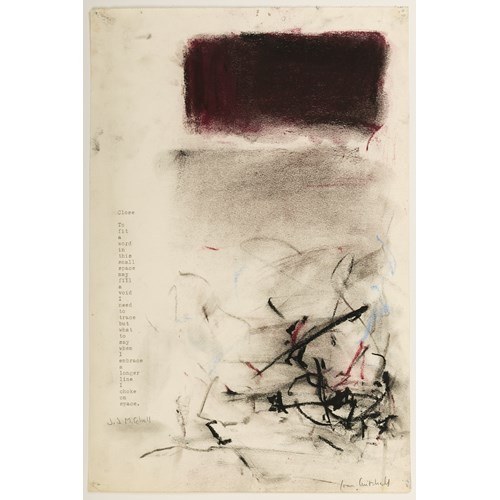Joseph Mallord William Turner
The Lauerzersee with the Ruins of Schwanau and the Mythens, Switzerland
The watercolours of Swiss views that Turner produced during his final tours of the country in the first half of the 1840s, of which the present sheet is a particularly fine example, have long been recognized as among his most remarkable works on paper. Not long after the artist’s death they began to be highly prized by collectors. As Turner’s great champion John Ruskin noted of such watercolours as the present sheet, ‘I look upon them as in some respects, more valuable than his finished drawings, or his oil pictures; because they are the simple records of his first impressions and first purposes, and in most instances as true to the character of the places they represent as they are admirable in composition.’
This luminous watercolour, in exceptional condition, depicts Lake Lauerz, or the Lauerzersee. Located near the town of Schwyz, the Lauerzersee lies twenty-two kilometres east of the city of Lucerne and not far from the town of Brunnen on Lake Lucerne. Turner had first visited the area on his initial Swiss journey of 1802, and returned there during his sketching tours of 1842, 1843 and 1844, although it was in 1843 that he explored the Lauerzersee and its surroundings most extensively. On these excursions he carried with him one of his ‘roll sketchbooks’ of Whatman paper, with which he set down scenes that would be the basis of later, more finished watercolours. These ‘roll’ sketchbooks with soft paper covers, which could be rolled up and carried in a coat pocket, were used by Turner for more comprehensive studies in colour than the rapid pencil sketches which filled his smaller pocket sketchbooks.
The present sheet comes from one of the ‘roll’ sketchbooks that Turner used on his Swiss tours. While the precise location depicted here remained a mystery for early scholars and collectors, it has since been firmly identified as the Lauerzersee. Turner appears to have drawn this watercolour from the road along the southern edge of the small lake, about a mile from the village of Lauerz. At the left of the composition is the island of Schwanau with its ruined castle, the Burgruine Schwanau, and at the right are the lower slopes of the Urmiberg mountain, while in the distance rise the distinctive twin peaks of the mountains known as the Grosser and Kleiner Mythen. Drawn in a fine pencil at the far end of the lake is what is probably the prominent 16th century church tower of the lakeside village of Seewen, close to Schwyz.
As Ian Warrell has noted of the present watercolour, ‘Having defined the structure of the scene so deftly in his under-drawing, Turner added washes of diluted yellow and blue, leaving traces of hasty movements with his brush; or blending them at times to add green, a colour that is surprisingly rare in his works. These overlapping tones are given more tangible substance through the addition of economic penwork, at times as neat as lines of knitting, and elsewhere more freely calligraphic.’ Warrell has likened the present sheet, in stylistic and tonal terms, to a number of other watercolours of c.1842-1843 from the same or a similar ‘roll sketchbook’. These include three ‘sample studies’, all of identical size to the present sheet, in the Turner Bequest at the Tate; Arth, on the Lake of Zug, Early Morning, Küssnacht, Lake of Lucerne, and The Pass of St. Gotthard, near Faido, as well as The Pass of St. Gotthard in the Museum of the Rhode Island School of Design in Providence, Rhode Island and a view of Schwyz in the Vaughan Bequest at the National Galleries of Scotland in Edinburgh. Several of these watercolours were developed into more finished works on paper, and the same is true of this view of the Lauerzersee with the Ruins of Schwanau and the Mythens.
It has been suggested that the present sheet may have been part of a group of fifteen watercolour sketches - done as ‘sample studies’ with a view to obtaining commissions for larger, finished watercolours - seen by Ruskin on the 10th of May 1844 and noted in his diary that day; two of this group are today in the Turner Bequest at the Tate in London and four more are in the Fitzwilliam Museum in Cambridge, while single sheets are in the Courtauld Gallery and the Victoria and Albert Museum in London. This watercolour of The Lauerzersee with the Ruins of Schwanau and the Mythens was not, however, used by the artist until several years later, when it served as the basis for one of his final ten finished watercolours of Swiss views, The Lauerzersee with the Mythens of c.1848, acquired by Turner’s patron Henry Vaughan and today in the collection of the Victoria and Albert Museum in London. The later finished watercolour, however, lacks the lightness and vibrant tones of the present study.
The provenance of this watercolour can be traced back to Turner himself, since it was given by the artist to his housekeeper and devoted companion Sophia Caroline Booth (1798-1878). Of German descent, Sophia was born in Dover and at the age of twenty married a local fisherman named John Henry Pound, who died in 1821, leaving her with an infant son, Daniel Pound. Four years later she married John Booth of Margate, and established a boarding house on the seafront there, where Turner would stay on his visits to Margate. After Mrs. Booth was widowed for a second time in 1833, Turner formed a close relationship with her. In 1846 Sophia Booth and her son Daniel moved from Margate to London, where Turner had bought a house for them in Chelsea, overlooking the Thames. She continued to look after Turner until his death in 1851. Turner presented her with numerous drawings and watercolours, including this Lauerzersee with the Ruins of Schwanau and the Mythens, as well as at least eight oil paintings.
The present sheet is among Turner’s most beautiful late Swiss watercolours, with the artist’s rapid technique and delicate washes combining to contrast the atmospheric effects of the calm surface of the lake with the mountains in the haze behind. There is a sense of abiding calmness and tranquility in this composition, in which an expansive view has been encapsulated on a small sheet of paper. Indeed, Turner’s ability to apply a rapid technique and confident brushstrokes to capture atmospheric effects of light and colour on a relatively modest scale is one of the hallmarks of his genius as a watercolourist. As the Turner scholar Andrew Wilton has aptly noted of such atmospheric late views as the present sheet, ‘watercolour was the logical, indeed the only, medium for this engagement with Swiss light and air…Turner’s interpretation of the Swiss atmosphere is so vivid, so strong, and expansive that the broad foundations of his classically-based compositions seem to be disintegrated by it; it is the air itself that expresses the monumentality of the landscape.’
Provenance: Given by the artist to Mrs. Sophia Caroline Booth, Margate and London
By descent to her son, Daniel John Pound
By descent to his widow, Mary Anne Pound
Given by her to Alfred and Kate Austin, Hove, Sussex
Their anonymous sale, London, Christie’s, 11 June 1909, lot 185 (as ‘A View on the Rhine’, bt. Agnew’s for £346.10)
Thomas Agnew and Sons, London
Acquired from them by Walter H. Jones, Hurlingham Lodge, Fulham, London
By descent to his widow, Maud Jones, Hurlingham Lodge, London, and Aberuchill Castle, Perthshire, Scotland
Her posthumous sale, London, Christie’s, 3 July 1942, lot 49 (as ‘The Lake of Lucerne: Brunnen in the distance. Painted about 1840. 9 in. by 11 in.', bt. Agnew’s for £420)
Thomas Agnew and Sons, London
L. B Murray, in 1951, and by descent to his son
Private collection, in 1979
Sold by Agnew’s in June 1983 to D. Hoener, New York
Anonymous sale, New York, Sotheby’s, 21 May 1987, lot 30
A. Alfred Taubman, Bloomfield Hills, Michigan
His (anonymous?) sale, London, Sotheby’s, 11 April 1991, lot 77
Anonymous sale, London, Christie’s, 9 July 1996, lot 41
Jacob) Eli Safra, Geneva
His anonymous sale, New York, Sotheby’s, 28 January 2016, lot 61.
Literature: A. J. Finberg, Early English Water-Colour Drawings by the Great Masters [Special Number of The Studio], London, Paris and New York, 1919, pp.20 and 45, no.130, illustrated in colour pl.XX; Andrew Wilton, The Life and Work of J. M. W. Turner, Fribourg and London, 1979, pp.478-479, no.1488 (‘The Lowerzersee, with Schwytz and the Mythen’, where dated 1843(?); ‘News and Sales Record,’ Turner Studies: His Art & Epoch 1775-1851, Summer 1987 (Vol.7 No.1), p.64; Eric Shanes, ‘Picture Notes: 1. The Lauerzer See, with the Mythens (hitherto entitled ‘Lake Brienz’), W.1562...Victoria and Albert Museum. 2. The Lauerzer See with Schwytz and the Mythen, W.1488…Private Collection, U.S.A.)’, Turner Studies: His Art & Epoch 1775-1851, Winter 1987 (Vol.7 No.2), pp.58-59; ‘News and Sales Record,’ Turner Studies: His Art & Epoch 1775-1851, Summer 1991 (Vol.11 No.1), p.60; Ian Warrell, Through Switzerland with Turner: Ruskin’s First Selection from the Turner Bequest, exhibition catalogue, London, 1995, p.71, under no.32; Terence Rodrigues, ed., Christie’s Review of the Year 1996, London, 1996, p.49; Eric Shanes, Turner: The Great Watercolours, exhibition catalogue, London, 2000-2001, p.238, under no.110; Eric Shanes, La Vie et les chefs d'oeuvre de J.M.W. Turner, New York, 2008, p.239; Martin Krause, ‘Mrs. Booth’s Turners’, The British Art Journal, 2021, No.1, pp.6 and 8, illustrated p.9, fig.4.
Exhibition: London, Thos. Agnew and Sons, Exhibition of Selected Water-Colour Drawings, 1910, no.184 (as ‘On the Rhine’); London, Thos. Agnew and Sons, Exhibition of Water-Colour Drawings by Joseph Mallord William Turner R.A., 1913, no.117 (as ‘View on the Rhine. View of a bend in the river with castle on the left, and on either side snow-clad peaks; moon rising. 8 3/4 x 11 1/4.’); London, Thos. Agnew and Sons, Exhibition of Water Colour Drawings by Artists of the Early English School, 1919, no.130 (as ‘Lake of Lucerne: Brunnen in the distance.’); London, Thos. Agnew and Sons, Centenary Loan Exhibition of Water-Colour Drawings by J. M. W. Turner, R.A., 1951, no.96 (‘The Lowerzer See, with Schwyz and the Myttenberg. c.1840. Formerly known as “The Lake of Lucerne, Brunnen in the distance.”’); London, Thos. Agnew and Sons, Loan Exhibition of Paintings and Watercolours by J. M. W. Turner, R.A., 1967, no.80 (‘The Lowerzer See with Schwyz and the Myttenberg in the Distance’); Zurich, Kunsthaus Zurich, Turner und die Schweiz, 1976-1977, no.43 (‘Lauerzer See, um 1841’); London, Agnew’s, Turner Watercolours: Watercolours by J. M. W. Turner R.A. (1775-1851), 1994, no.8 (‘The Lauerzersee with Schwyz and the Mythen’).
More artworks from the Gallery







_T638203653890241467.jpg?width=500&height=500&mode=pad&scale=both&qlt=90&format=jpg)

